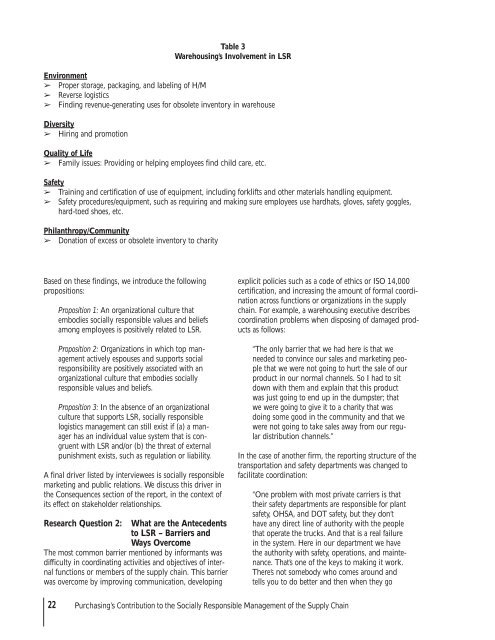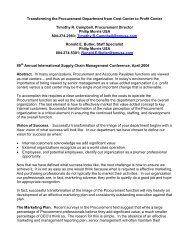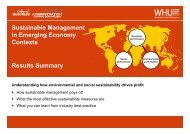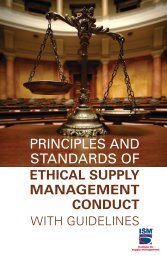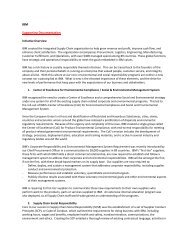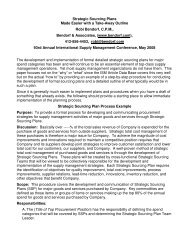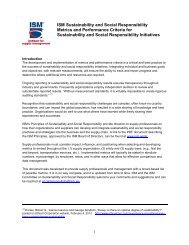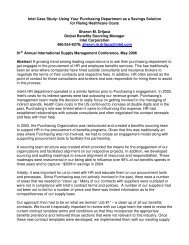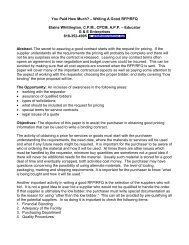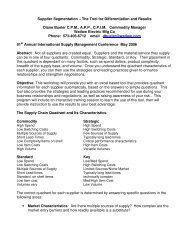Purchasing's Contribution to the Socially Responsible Management ...
Purchasing's Contribution to the Socially Responsible Management ...
Purchasing's Contribution to the Socially Responsible Management ...
You also want an ePaper? Increase the reach of your titles
YUMPU automatically turns print PDFs into web optimized ePapers that Google loves.
Based on <strong>the</strong>se findings, we introduce <strong>the</strong> following<br />
propositions:<br />
Proposition 1: An organizational culture that<br />
embodies socially responsible values and beliefs<br />
among employees is positively related <strong>to</strong> LSR.<br />
Proposition 2: Organizations in which <strong>to</strong>p management<br />
actively espouses and supports social<br />
responsibility are positively associated with an<br />
organizational culture that embodies socially<br />
responsible values and beliefs.<br />
Proposition 3: In <strong>the</strong> absence of an organizational<br />
culture that supports LSR, socially responsible<br />
logistics management can still exist if (a) a manager<br />
has an individual value system that is congruent<br />
with LSR and/or (b) <strong>the</strong> threat of external<br />
punishment exists, such as regulation or liability.<br />
A final driver listed by interviewees is socially responsible<br />
marketing and public relations. We discuss this driver in<br />
<strong>the</strong> Consequences section of <strong>the</strong> report, in <strong>the</strong> context of<br />
its effect on stakeholder relationships.<br />
Research Question 2: What are <strong>the</strong> Antecedents<br />
<strong>to</strong> LSR – Barriers and<br />
Ways Overcome<br />
The most common barrier mentioned by informants was<br />
difficulty in coordinating activities and objectives of internal<br />
functions or members of <strong>the</strong> supply chain. This barrier<br />
was overcome by improving communication, developing<br />
Table 3<br />
Warehousing’s Involvement in LSR<br />
Environment<br />
➢ Proper s<strong>to</strong>rage, packaging, and labeling of H/M<br />
➢ Reverse logistics<br />
➢ Finding revenue-generating uses for obsolete inven<strong>to</strong>ry in warehouse<br />
Diversity<br />
➢ Hiring and promotion<br />
Quality of Life<br />
➢ Family issues: Providing or helping employees find child care, etc.<br />
Safety<br />
➢ Training and certification of use of equipment, including forklifts and o<strong>the</strong>r materials handling equipment.<br />
➢ Safety procedures/equipment, such as requiring and making sure employees use hardhats, gloves, safety goggles,<br />
hard-<strong>to</strong>ed shoes, etc.<br />
Philanthropy/Community<br />
➢ Donation of excess or obsolete inven<strong>to</strong>ry <strong>to</strong> charity<br />
explicit policies such as a code of ethics or ISO 14,000<br />
certification, and increasing <strong>the</strong> amount of formal coordination<br />
across functions or organizations in <strong>the</strong> supply<br />
chain. For example, a warehousing executive describes<br />
coordination problems when disposing of damaged products<br />
as follows:<br />
“The only barrier that we had here is that we<br />
needed <strong>to</strong> convince our sales and marketing people<br />
that we were not going <strong>to</strong> hurt <strong>the</strong> sale of our<br />
product in our normal channels. So I had <strong>to</strong> sit<br />
down with <strong>the</strong>m and explain that this product<br />
was just going <strong>to</strong> end up in <strong>the</strong> dumpster; that<br />
we were going <strong>to</strong> give it <strong>to</strong> a charity that was<br />
doing some good in <strong>the</strong> community and that we<br />
were not going <strong>to</strong> take sales away from our regular<br />
distribution channels.”<br />
In <strong>the</strong> case of ano<strong>the</strong>r firm, <strong>the</strong> reporting structure of <strong>the</strong><br />
transportation and safety departments was changed <strong>to</strong><br />
facilitate coordination:<br />
“One problem with most private carriers is that<br />
<strong>the</strong>ir safety departments are responsible for plant<br />
safety, OHSA, and DOT safety, but <strong>the</strong>y don’t<br />
have any direct line of authority with <strong>the</strong> people<br />
that operate <strong>the</strong> trucks. And that is a real failure<br />
in <strong>the</strong> system. Here in our department we have<br />
<strong>the</strong> authority with safety, operations, and maintenance.<br />
That’s one of <strong>the</strong> keys <strong>to</strong> making it work.<br />
There’s not somebody who comes around and<br />
tells you <strong>to</strong> do better and <strong>the</strong>n when <strong>the</strong>y go<br />
22 Purchasing’s <strong>Contribution</strong> <strong>to</strong> <strong>the</strong> <strong>Socially</strong> <strong>Responsible</strong> <strong>Management</strong> of <strong>the</strong> Supply Chain


